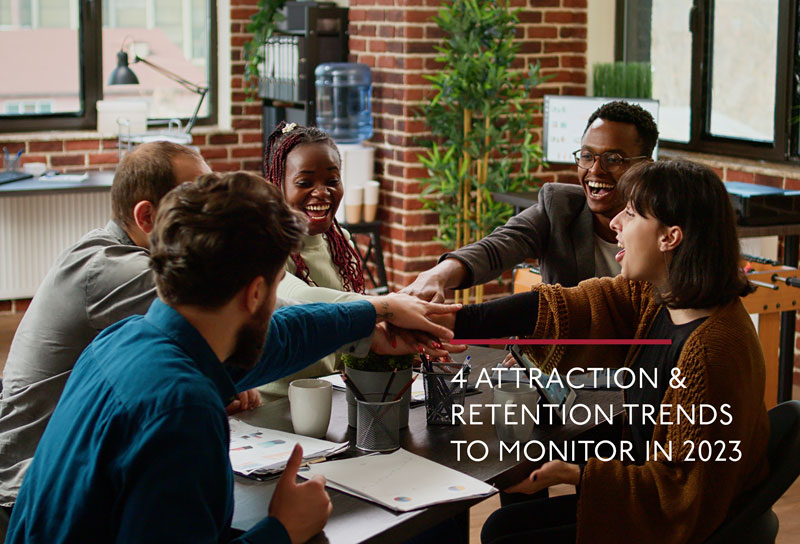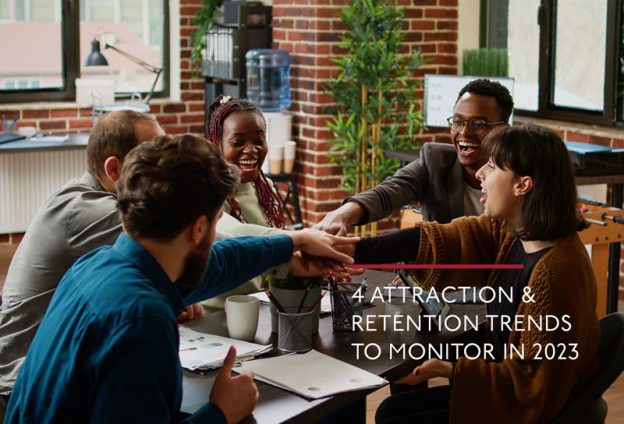
Last year’s labor market was a roller coaster and we believe 2023 will be no different. A lot is uncertain but one thing is clear: employers will struggle to compete for top talent. Labor metrics indicate that though the market has slightly improved over last year, it’s still a tight labor market, numbers remain historically high. While most employers project an increase in salaries in 2023, many will look beyond pay alone to help attract and retain current and prospective employees.
While some companies have been offering higher compensation and better benefits packages, many organizations also are looking for other ways to optimize their offerings and enhance employee experience. As they compete for talent, many may take a total rewards approach to fulfill employees’ workplace desires. Today, we’re talking about four attraction and retention trends to watch in 2023.
1. Redesigned Flexibility
Remote work exploded at the height of the pandemic and many organizations shifted to a flexible work model out of necessity. Nearly three years later, having flexible and remote work models has shifted from a perk to a given. Employees want the flexibility to work when and where they want.
For employers, it’s essential to balance organizational goals with employee desires. It’s important to adapt to employee expectations around flexible work models while also keeping an eye on business priorities that might call for having employees back in the office. While workplace flexibility is not always feasible, employers can evaluate their own situations and consider ways to develop flexible arrangements. The goal is to focus on output and productivity rather than time spent online or in the workplace.
2. Mental Health Support
Between the pandemic, inflation and job duties, more employees feel burnt out or are battling mental health challenges. More employers will be considering how to take a proactive approach towards employee mental well-being and resilience. A survey from the employee wellness platform, Gympass, revealed that nearly half of employees (48%) say their well-being declined in 2022. In addition, 28% say they are miserable at work. Health experts predict that employees’ mental health will continue to decline amid economic uncertainty, which means the demand for mental health care will increase in 2023.
Employers can offer benefits, perks, and wellness programs designed to support mental well-being. To address burnout, many employers will offer or expand their employee assistance programs, behavioral health anti-stigma campaigns, and training for recognizing employee and peer behavioral health issues. Employers are poised to offer the education and support that today’s workers need and are looking for.
3. Learning and Development Opportunities
Learning and developing efforts have been on the rise in recent years. Not only are workers looking for professional growth opportunities at an employer, but many organizations are upskilling or reskilling workers, as it’s often less expensive to reskill a current employee than hire a new one. On the flip side, employees who receive learning and development opportunities are more likely to stay with the company and grow into different roles. Therefore, learning and development initiatives prove to be a win-win situation for employers and employees.
As employers go head-to-head in the competitive race for talent in 2023, upskilling their current workforces could be a solution to finding workers for their in-demand roles. Furthermore, organizations are prioritizing internal mobility to address skills gaps and strengthen employee retention.
4. Increased Focus on Belonging
Nurturing a sense of belonging is a critical component of company culture. At work, belonging is the experience of employees feeling accepted and included by those around them. While belonging doesn’t necessarily come with a price tag, employers can invest efforts and resources into ensuring their workplaces are inclusive, collaborative, and connected. Employees are looking for a work environment that’s authentic and accepting. A focus on belonging can play a crucial role in improving workplace culture.
Many workplace factors can impact employees’ sense of belonging, including company culture, benefits offerings, communication methods, learning and development resources and mental health support. Any day-to-day interactions among co-workers and managers or companywide initiatives may impact workplace culture and the overall employee experience. When an organization develops reputation for being an inclusive and supportive workplace, new talent is eager to join. Employers can elevate employee experiences by creating workplaces where employees feel they belong and can be their authentic selves.
Summary
Employers can get ahead of the game in 2023 by monitoring the trends shaping the ever-evolving labor market and driving current and prospective employees’ needs and wants. While attraction and retention challenges are likely to continue this year, these trends demonstrate ways employers can elevate and strengthen their talent strategies to win and keep more workers.
Reach out to CorpStrat for more guidance on these topics and other employee attraction and retention trends.








